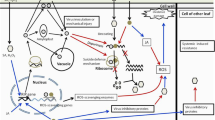Abstract
The diseases of plants caused by viruses are always in main concern for researchers because they reduced the yield and quality of food grains or horticultural products like fruits, vegetables and flowers which will leads a major economic loss of agricultural stakeholders. Presently there is no direct control strategy for viral infection in plants. Advancement in technology leads a novel approach which uses peptide aptamers for controlling plant virus. This technology is effective because the peptide aptamers are specific and binds directly with the capsid protein (CP), nucleoproteins (N) and movement proteins (MP) and affect viral replication machinery of plant virus. In this chapter, we reviewed the about role of peptide aptamers for inhibiting the viral infection in plants.
Access this chapter
Tax calculation will be finalised at checkout
Purchases are for personal use only
Similar content being viewed by others
References
Acero FJF, Carbú M, El-Akhal MR, Garrido C, González-Rodríguez VE, Cantoral JM (2011) Development of proteomics-based fungicides: new strategies for environmentally friendly control of fungal plant diseases. Int J Mol Sci 12:795–816
Briddon RW, Stanley J (2009) Geminiviridae. Encyclopedia of life science. Wiley, Chichester
Colombo M, Mizzotti C, Masiero S, Kater MM, Pesaresi P (2015) Peptide aptamers: the versatile role of specific protein function inhibitors in plant biotechnology. J Integr Plant Biol 57:892–901. https://doi.org/10.1111/jipb.12368
Komorowska B, Hasiów-Jaroszewska B, Minicka J (2017) Application of nucleic acid aptamers for detection of apple stem pitting virus isolates. Mol Cell Probes 36:62–65
Lopez-Ochoa L, Ramirez-Prado J, Hanley-Bowdoin L (2006) Peptide aptamers that bind to a geminivirus replication protein interfere with viral replication in plant cells. J Virol 80:5841–5853
Maffei G, Miozzi L, Fiorilli V, Novero M, Lanfranco L, Accotto GP (2013) The arbuscular mycorrhizal Symbiosis attenuates symptom severity and reduces virus concentration in tomato infected by tomato yellow leaf curl Sardinia virus (TYLCSV). Mycorrhiza 24:179–186. https://doi.org/10.1007/s00572-013-0527-6
Mendoza-Figueroa JS, Soriano-García M, Valle-Castillo LB, Méndez-Lozano J (2014) Peptides and peptidomics: a tool with potential in control of plant viral diseases. Adv Microbiol 4:539–548
Mendoza-Figueroa JS, Kvarnheden A, Méndez-Lozano E-A, Rodríguez Negrete J, Arreguín-Espinosa de los Monteros R, Soriano-García M (2018) A peptide derived from enzymatic digestion of globulins from Amaranth shows strong affinity binding to the replication origin of Tomato yellow leaf curl virus reducing viral replication in Nicotiana benthamiana. Pestic Biochem Physiol 145:56–65. https://doi.org/10.1016/j.pestbp.2018.01.005
Muthamilarasan M, Prasad M (2013) Plant innate immunity: an updated insight into defense mechanism. J Biosci 38:433–449. https://doi.org/10.1007/s12038-013-9302-2
Nicaise V (2017) Boosting innate immunity to sustainably control diseases in crops. Curr Opin Virol 26:112–119. https://doi.org/10.1016/j.coviro.2017.07.030
Reyes MI, Nash TE, Dallas MM, Ascencio-Ibáñez JT, Hanley-Bowdoin L (2013) Peptide aptamers that bind to geminivirus replication proteins confer a resistance phenotype to tomato yellow leaf curl virus and tomato mottle virus infection in tomato. J Virol 87:9691–9706
Rudolph C, Schreier PH, Uhrig JF (2003) Peptide-mediated broad-spectrum plant resistance to tospoviruses. Proc Natl Acad Sci U S A 100:4429–4434
Shepherd DN, Martin DP, Thomson JA (2009) Transgenic strategies for developing crops resistant to geminiviruses. Plant Sci 176:1–11
Takashi S (2017) Use of peptide aptamers, cationic peptides and artificial zinc finger proteins to generate resistance to plant viruses. Curr Opin Virol 26:120–124. https://doi.org/10.1016/j.coviro.2017.07.023
Author information
Authors and Affiliations
Editor information
Editors and Affiliations
Rights and permissions
Copyright information
© 2019 Springer Nature Singapore Pte Ltd.
About this chapter
Cite this chapter
Yadav, P.K., Kumar, S., Yadav, S., Kumar, S. (2019). Role of Aptamers in Plant Defense Mechanism Against Viral Diseases. In: Yadav, G., Kumar, V., Aggarwal, N. (eds) Aptamers. Springer, Singapore. https://doi.org/10.1007/978-981-13-8836-1_11
Download citation
DOI: https://doi.org/10.1007/978-981-13-8836-1_11
Published:
Publisher Name: Springer, Singapore
Print ISBN: 978-981-13-8835-4
Online ISBN: 978-981-13-8836-1
eBook Packages: Biomedical and Life SciencesBiomedical and Life Sciences (R0)




